Art Essay: India, Heaven for an Artist
By Deborah Howland-Murray
arttimesjournal May 23, 2020
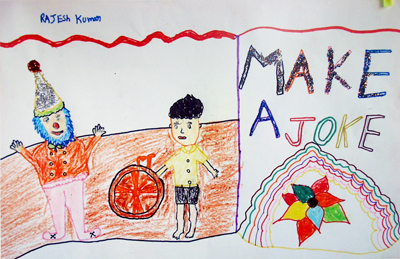 Rajesh's Conflict Resolution Poster~ 4th standard |
The India I love is a sensual feast. Perfumed jasmine; burning plastic. Brilliant saris; biting poverty. Flowers in ebony hair, red dirt, white teeth, coffee brown skin, and huge smiles.
India is heaven for an artist. I could barely contain my excitement at the prospect of teaching art for a month at the bi-lingual Aikiyam school, in the southeastern village of Kuilapalayam. My daughter-in-law, Meghan, was teaching there while she and my son spent a year in India. I agreed to visit, but only if I could work. It was quickly arranged that I would team with Ramalingam, Aikiyam’s art teacher.
Indian spontaneity thwarted my attempts to engage Shankar, the school’s director, in prior planning. I knew Aikiyam needed books, and that students who learned in English as well as their native Tamil, needed to hear English from native speakers. So, I packed one suitcase with my belongings, and one with art supplies and children’s books that I intended to use as a basis for our projects. The rest would have to grow organically when I arrived.
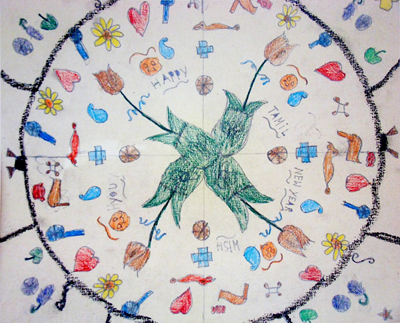 Nitish's Mandala, Wish You Happy Tamil New Year~ 3rd standard |
Aikiyam’s classrooms are housed in individual, spaceship-like pods. Ramalingam showed me students’ work during a first meeting in the art room pod. Most was done in small sketchbooks, with very limited materials, themes, and technique. Their sense of color, pattern and design was exquisite, but the work lacked dimension and creativity. Black outlines and flat areas of color were the norm. Though beautiful, rigid adherence to a prescribed style made it difficult to differentiate one child’s work from another’s. I saw an opportunity to help them become as free in their artistic self-expression as they were with their abundant warmth and hugs of affection.
I met with each of the 1st- 6th standards, or grades, twice a week; once for literature and once for art. Considering India’s pervasive de facto caste system, economic inequality and religious diversity, I brought books with themes of building peace, working together and appreciating differences.
Our first books, “The Butter Battle Book,” by Dr. Seuss, Chris Raschka’s “Yo! Yes!,” and “It’s Mine,” Leo Lionni, all focused on the advantages of living peacefully together. We discussed warring versus peaceful attitudes, and then created peace murals to depict the perfect world we hoped for. Students readily gravitated to the oil pastels, markers, glitter, pipe cleaners, woodless colored pencils, and better quality and larger sizes of paper I brought. But it was quite a challenge to help Aikiyam’s students think creatively and conceptually. Though many students drew large numbers of flowers and houses and butterflies, some of the students really got it. Nitish drew a lion becoming friends with a goat; Jayam drew three people meditating, their skin colors varying tones of greens, blues and purples. Ayyanar’s scene was reminiscent of Noah’s Ark, with different people and all manner of animals coexisting.
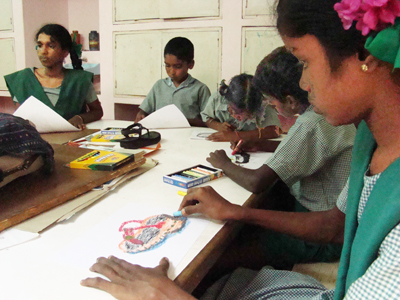 Manjula uses bright colors to draw a sandal~ 7th standard |
Art was one of several options offered to 3rd- 8th standard students for the final period of the day. I decided to confront the creativity issue head on. The first day we started pencil drawings, and after eight minutes students shared their drawings with the class. Then I asked them to turn their drawings upside down and continue their drawings non-representationally. The results were creative, but still constrained by the traditional outlines and fields of flat color.
The following day I had them draw my sandal, using only the sides of the oil pastels I gave them. No lines — just masses of color to create light and dark. My sandal was black, but soon we had very whimsical, tropical sandal drawings, sans outlines!
Our third project went a step further. The students were excited about the upcoming harvest festival of Pongal. We talked about their feelings regarding this fun holiday with its huge feast and parade of decorated cows. I asked them to draw those feelings, with one caveat - nothing representational. They looked at me blankly. I had them picture the colors and shapes and smells of Pongal. What colors are happy? Excited? Loud? What kind of lines does a delicious smell draw in the air? Do hard angles or soft curves describe Pongal? When they returned to drawing, beautiful abstracts blossomed on the paper. This was a tremendous stretch for the children. I was so thrilled, I hopped around the room, displaying paper after paper to the class.
For literature, we turned next to “Alexander and the Terrible, Horrible, No Good, Very Bad Day,” by Judith Viorst. We all have no good, very bad days and with luck, someone will understand how we feel when we do. But India is not a psychology-oriented society and corporal punishment is accepted as the norm. A child’s feelings often go unaddressed. After reading the book, the children created two masks each in art class; one portrayed the face they showed the world, the other expressed the feelings they often kept hidden. Pachayappan showed himself on the one hand with a glittery gold crown and huge smile; on the other hand, with a deep frown and knit eyebrows.
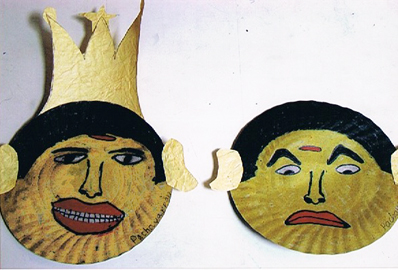 Pachayappan's Masks ~ 4th Standard |
“Stone Soup,” a European folktale in which hungry travelers find an ingenious solution to engage the cooperation of miserly townspeople, got us thinking about alternatives to using our bodies to resolve conflict. In each class we compiled a list of positive responses to conflict – “See Cool Colors,” “Ask for What You Want,” “Drink Water,” “Count to Ten,” “Get a Grownup to Help,” “Meditate,” “Use Your Words,” and since Indians love their sweets, “Eat Chocolate,” to name a few. Each student chose one of the methods and made a poster illustrating it. When finished, we hung their posters in the pods for easy reference in heated moments. For this project, I introduced the idea of a working study. I allowed outlines for accuracy, but since they practiced their design beforehand, students were less reliant on outlines for the finished version. These posters also represented a departure from areas of flat color, with more color blending and dark and light tones for shading.
Concepts of self-expression and the value of creativity were new to Aikiyam’s teachers, as well. At Shankar’s request, Meghan and I offered a workshop for the staff entitled “Art as Expression.” Meghan handled creativity’s relationship to teaching. Before she did, I had them make a series of three drawings. First, I instructed them to draw something familiar, and then reflect upon what they had done. Most agreed they liked their results. Then, they started the same drawing again on a new sheet of paper. After a few minutes, I had them turn their papers upside down, forcing a new vision for their drawings. Again, they reflected. For the third drawing, they started their familiar image once more, but with their eyes closed. After the final version, they met in small groups and shared their drawings and experiences. When the groups reported their findings, teachers said they felt freer when unshackled by realism. We observed selected examples of the children’s art, comparing the “pretty” pieces with some that were more expressive. Teachers concluded the expressive pieces were more exciting and gave them more insight into their students.
I felt an overwhelming sense of purpose every day in India. I called my husband to sound out staying an extra month. “What took you so long?” was his reply.
With a second month to spend teaching Aikiyam‛s children, I chose another peace-related project for the 1st - 3rd standard children, one that integrated entirely with the students‛ culture. After a group meditation, beautiful mandalas sprouted up at Aikiyam school. The children’s refined sense of patterning and color made for gorgeous designs.
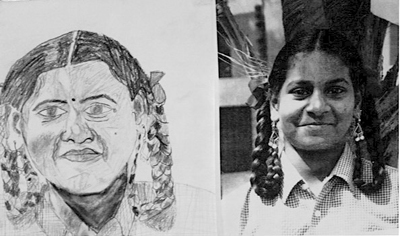 Priyadarshini's Photo and Self-portrait~ 6th Standard |
I went in the opposite direction for the 4th - 6th standards – self-portraits After I took their pictures and printed the photos, I offered a portrait demo, with techniques for creating light and shadow and some basic mathematical rules of thumb for drawing the face. Some of them were so excited they greeted me with many drawings of their family members, created at home. For children who have so little, their excitement had to do in part with possessing a printed photo of their own, using real drawing pencils and high quality paper, and experiencing books with great master portraits.
Their drawings reflected how seriously they took the project. We had come full circle. The features were defined with areas of light and shadow and subtly rendered tonal variance. Many of the likenesses were identifiable without looking at the name on the paper.
Ramalingam was ecstatic. He enthusiastically conceived of an art show to celebrate all the work our young artists had accomplished in the past two months. On my last day, Aikiyam‛s open air dining hall was turned into a gallery. Throughout school hours, parents, villagers and even local press streamed through our exhibition. Joy and pride spread across each beautiful brown face. And, of course, there were sweets and delicious chai, just as rich and spiced as India. I made a silent vow to return next year.
